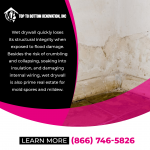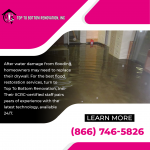Property owners who face water damage in their homes or businesses may not know if they need to replace their drywall. Sometimes, the source is easily identifiable, like a flood or a leaky faucet. Either way, they'll want to explore flood restoration services.
A homeowner's first concern should be to get all the water out of their home. After completely drying out their home, it's time to explore what they can and can't restore.

Unfortunately, residents typically need to replace wet drywall in Fort Washington, Maryland, after a flood. This guide will explore how to assess flood damage and when it's necessary to replace drywall.
Why It’s Necessary to Replace Drywall in Most Cases
In most cases, flood restoration services will recommend a homeowner replace their drywall. Even when drywall doesn't appear to have accumulated a lot of moisture, water can still be inside its interior spaces.
Wet drywall quickly loses its structural integrity when exposed to flood damage. Besides the risk of crumbling and collapsing, soaking into insulation, and damaging internal wiring, wet drywall is also prime real estate for mold spores and mildew.
These mold spores can quickly travel throughout a home's ventilation system, wreaking havoc on a home and a family's health. Even individuals without health concerns like asthma or allergies can become sick from mold.
The last concern with wet drywall is that detecting lingering moisture can be challenging for most homeowners. Mold can thrive off even a little bit of moisture. Therefore, it's better to implement flood restoration services, ensuring homeowners fully resolve the problem.
Assessing and Dealing with Flood Damage
Following a flood from a weather event or plumbing leak, a team of water damage technicians can assess a homeowner's drywall. This testing process typically involves two steps:
Testing the Homeowner's Drywall
Two main methods exist for testing a homeowner's actual drywall. The first method uses a non-penetrating meter that detects moisture on the drywall's surface.
Other times, technicians may also remove baseboards and make a small hole in the drywall using a tool like a screwdriver. Soft drywall indicates that moisture is present.
Testing the Homeowner's Interior Wall
Next, technicians will use a penetrating device to test a homeowner's internal wall(s). Technicians may also check a homeowner's insulation and wall studs for water damage.
What Happens When There's Moisture
Sometimes, homeowners can avoid replacing their drywall. Besides looking for warping, discoloration, etc., technicians will assess if drywall has mold or is in danger of developing mold.
If no mold or other problems are present, technicians can use industrial fans and dehumidifiers to dry a person's drywall. However, technicians recommend that a homeowner replace wet cellulose and fiberglass insulation.
Besides excessive moisture and mold spores, homeowners should also replace drywall when there's grey or blackwater damage. These two types of water include flooding from sewage, water from appliances such as dishwashers, stormwater, and wastewater.
The Best Water Damage Restoration Services from Top To Bottom Renovation, Inc.
After water damage from flooding, homeowners may need to replace their drywall. For the best flood restoration services, turn to Top To Bottom Renovation, Inc. Their IICRC-certified staff pairs years of experience with the latest technology, available 24/7.

Discover Top to Bottom Inc.’s flood restoration services by calling (866) 746-5826!
































